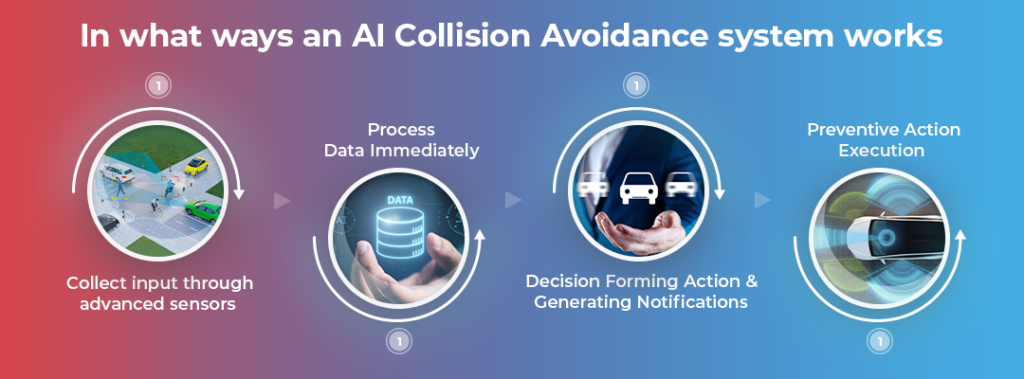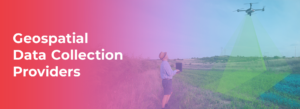- What Is Collision Avoidance Technology?
- Why AI Is a Game-Changer for Collision Avoidance Systems
- AI In Collision Avoidance – Key Highlights
- In what ways an AI collision avoidance system works
- A Testament in Action: Case Studies
- The Future of AI-Powered Collision Avoidance Systems
- The Ripple Effect on Driving Safety
How Do AI-Powered Collision Avoidance Systems Work?
How about imagining a vehicle that is fitted with technologies that can sense a potential collision and avoid it as the driver is still coming to terms with the impending danger. This is not a series of scenes from a science fiction work, as modern day AI-Powered Collision Avoidance Systems is making it achievable. Artificial Intelligence is changing the dynamic of how cars protect their drivers, other passengers, and pedestrians by incorporating advanced sensors and instant decision-making systems.
This blog is going to explain what collision avoidance technology is, how AI supercharges it, and what other impacts such innovation brings to the driving phenomenon. This analysis brings forth one of the most powerful intersections of AI and amalgamation of automotive engineering and safety systems which as a car lover, tech innovator, or a safety advocacy expert encourages you to learn more about it.
What Is Collision Avoidance Technology?
Collision avoidance technology includes advanced systems built in motor vehicles to minimize the chances of accidents. These technologies include some level of automation such as sensors and alert actions which are designed to receive and inform the operator about the risks such as oncoming vehicles, pedestrians or vehicles and enable the drivers to take actions in how to avoid the possibility of an accident.
Such systems used to depend on the utilization of cameras, radar, and basic algorithms which were able to make relative predictions and provide warnings on possible dangers. Although these systems improved safety on the roads, they did not have the sophistication often required for decision making in real time. The arrival of AI changed the game by providing the needed flexibility within collision avoidance systems.
Why AI Is a Game-Changer for Collision Avoidance Systems
AI has fundamentally changed the collision deterrent capabilities and effectiveness of AI powered collision avoidance systems and enables super advanced efficiency. AI is able to utilize AI and algorithms to assess and make decisions based on huge amounts of readily available data, multiple variables, learn from previous mistakes, and adjust predictions and estimates.
Macgence, focusing on data for training AI/ML models, plays a critical role in this technology transformation by offering substantial and heterogeneous data sets that sustain AI progression.
An AI-enhanced collision avoidance system doesn’t just identify potential threats — it also enacts a pre-planned response in milliseconds. The system employs machine learning (ML), integration of sensors, and predictive analytics to minimize – as much as possible – human error, which is one of the leading causes of crash incidents.
AI In Collision Avoidance – Key Highlights
Better Decision Making
AI simulates potential accident scenarios using factors such as speed, distance, and environmental conditions, and suggests preventive measures to avert a collision.
Adapt in Real Time
AI models improve over time as they have access to feedback loops. Every prevention successfully performed acts to strengthen the AI’s future performance.
Having a 360-degree view
AI collision avoidance systems use multiple cameras, radars, and LIDARs to systematically capture everything around the surrounding area of the vehicle in use.
In what ways an AI collision avoidance system works

Step 1: Collect input through advanced sensors
This process starts with the car’s surrounding area data gathering by the use of sensors. This includes the cameras used for detecting the lanes and passenger’s position, the LIDARs used for seismic scanning, and the radars detecting pace and vicinity of other cars.
Step 2: Process Data Immediately
The AI processes the information with the use of real life algorithms as soon as it is fed to it. Analyzing data together with historical versions allows the system to recognize possible dangers and threats.
Step 3: Coming Up with a Decision Forming Action and Generating Notifications
AI systems decide what actions need to be taken next based on what actions need to be optimally taken next.
For instance, if a pedestrian unexpectedly steps onto the path of the vehicle, the system is possibly able to trigger an AI collision avoidance warning system alert, apply emergency brakes and even guide the vehicle to steer autonomously.
Step 4: Preventive Action Execution
Regardless of engaging the brakes or an alert coming visually or audibly, AI ensures timely action is taken to avert a potential crash.
A Testament in Action: Case Studies
Tesla’s Autopilot Collision Prevention
A good example would be Tesla’s Autopilot. It makes use of AI together with a combination of sensors to monitor the traffic around the vehicle and prevent accidents in real-time. One specific incident in real life is preventing rear-end collisions by brake engagement milliseconds before impact.
Mobileye Technology
Mobileye has abandoned the predictive and reactive capabilities of AI collision avoidance to assist cities. Their systems have made it possible for urban planners to know the most accident prone areas hence speeding up citywide safety enhancement.
Mercedes-Benz Emergency Stop Assist
These days, Mercedes-Benz illustrates how systems that avoid collisions protect pedestrians. Emergency Stop Assist does not just see objects, it also registers their motions and anticipates the crossing pedestrian.
Such instances emphasize the fact that this technological advancement in collision avoidance safety systems contributes day by day driving safety.
The Future of AI-Powered Collision Avoidance Systems
AI driven collision avoidance systems definitely look forward to the day of having fully self-controlled vehicles.
Think of cars with neural networks that not only avoid collisions, but can also make driving decisions with precision in all types of environments and conditions.
Progress in autonomous driving will be complemented in the future by increased connectivity, for instance, with V2X (Vehicle-to-Everything) communication. In the future, AI collision avoidance warning systems will not only consider the surrounding environment, but also the surrounding infrastructure to guarantee that every corner and intersection is covered.
The Ripple Effect on Driving Safety
Integrating AI-powered collision avoidance systems goes beyond technology – it means that the roads will be safer for everyone. Here’s what could possibly happen:
Fewer Accidents: – The use of AI in the near future will significantly reduce human error, which will result in lower accident rates.
Lower Costs: – Fewer accidents mean lower insurance claims, which will reduce economic expenses.
A Sea of Confidence for Drivers Everywhere: – Consider the assurance that comes with knowing your car detects dangers that you would have likely missed.
These technologies are not farfetched but rather innovations that are already saving and protecting lives.
Share Your Thoughts on the Road Ahead
The development of AI-powered collision avoidance systems is changing the motor vehicle industry and its relations with the environment. The possibilities of this technology stretch far beyond the provision of safer cars towards urban design, logistics, and societal security.
Are you interested in how this technology is evolving? What about the prospects of fully autonomous cars excites you? We would love to hear your comments.
If you’re interested in AI advancements, companies like Macgence are leading the way by offering rich datasets. That significantly aid the AI/ML model training process. Moreover, if you would like your organization to be a participant or beneficiary of such advancements, don’t hesitate to reach out to us today!
We’ll work together to ensure innovation, and safety, continue to grow.
FAQs
Ans: – AI collision avoidance systems are very accurate because of their machine learning and real-time data processing capabilities. Their accuracy is also subject to the accuracy and variety of training data provided by companies such as Macgence.
Ans: – Absolutely! There is a growing trend of fitting external AI powered sensors to older vehicles. Offering collision protection while ensuring drivers do not have to purchase entirely new cars.
Ans: – These systems are common in premium and mid-tier vehicles. Due to increased affordability, are becoming more commonplace in all other market segments.
You Might Like
February 28, 2025
Project EKA – Driving the Future of AI in India
Artificial Intelligence (AI) has long been heralded as the driving force behind global technological revolutions. But what happens when AI isn’t tailored to the needs of its diverse users? Project EKA is answering that question in India. This groundbreaking initiative aims to redefine the AI landscape, bridging the gap between India’s cultural, linguistic, and socio-economic […]
April 5, 2025
The Ultimate Guide to Geospatial Data Collection Providers
Geospatial data collection has become an essential part of modern industries, playing a vital role in urban planning, environmental monitoring, transportation, agriculture, and defense. With the advent of advanced technologies such as artificial intelligence (AI), satellite imaging, drones, and LiDAR, the geospatial industry is witnessing a rapid transformation. In this blog, we will explore some […]
April 1, 2025
The Strategic Benefits of Partnering with Macgence for Model Evaluation and Validation
In the rapidly evolving AI landscape, ensuring robust model performance is not just an advantage—it’s a necessity. For businesses leveraging AI/ML technologies, partnering with a specialized validation partner like Macgence can mean the difference between unreliable prototypes and enterprise-grade AI solutions. At Macgence, we bring unmatched expertise in AI model evaluation and validation to help […]
March 24, 2025
Natural Language Generation (NLG): The Future of AI-Powered Text
The ability to generate human-like text from data is not just a sci-fi dream—it’s the backbone of many tools we use today, from chatbots to automated reporting systems. This revolution in artificial intelligence has a name: Natural Language Generation (NLG). If you’re an AI enthusiast or a tech professional, understanding NLG is essential for keeping […]


 Previous Blog
Previous Blog







